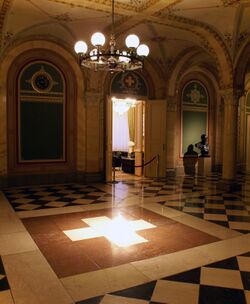Switzerland/Federal Council/Member
(The Swiss federal government) | |
|---|---|
 The interior of the west wing of the Federal Palace in Berne, where the Council meetings are held. | |
| Start | 1848 |
The Federal Council is the seven-member executive council that constitutes the federal government of the Swiss Confederation and serves as the collective head of state and government of Switzerland.
While the entire council is responsible for leading the federal administration of Switzerland, each councillor heads one of the seven federal executive departments. The position of President of the Swiss Confederation rotates among the seven councillors on a yearly basis, with one year's Vice President of the Federal Council becoming the next year's Confederation President.
Contents
Secrecy
The meetings of the Federal Council and the result of the votes taken are not open to the public, and the records remain sealed for 50 years. This has lately been the subject of some criticism. In particular, the parties at the ends of the political spectrum argue that this secrecy is contrary to the principle of transparency. However, the Council has always maintained that secrecy is necessary to arrive at consensus and to preserve the collegiality and political independence of the individual Councillors.
Grand coalition, 1959–2003
The 1959 elections, following the resignation of four Councillors, finally established the Zauberformel, the "magical formula" that determined the Council's composition during the rest of the 20th century and established the long-standing nature of the Council as a permanent, voluntary grand coalition.[1] In approximate relation to the parties' respective strength in the Federal Assembly, the seats were distributed as follows:
- Free Democratic Party (FDP): 2 members,
- Christian Democratic People's Party (CVP): 2 members,
- Social Democratic Party (SP): 2 members, and
- Swiss People's Party (SVP): 1 member.
During that time, the FDP and CVP very slowly but steadily kept losing voter share to the SVP and SP, respectively, which overtook the older parties in popularity during the 1990s.
End of the grand coalition, 2008
The governmental balance was changed after the 2003 elections, when the SVP was granted a Council seat for their leader Christoph Blocher that had formerly belonged to the CVP's Ruth Metzler. Due to controversies surrounding his conduct in office, a narrow Assembly majority did not reelect Blocher in 2007 and chose instead Eveline Widmer-Schlumpf, a more moderate SVP politician, against party policy. This led to a split of the SVP in 2008. After liberal regional SVP groups including Federal Councillors Widmer-Schlumpf and Samuel Schmid founded a new Conservative Democratic Party, the SVP was left in opposition for the first time since 1929, but returned into the Council with the election of Ueli Maurer on 10 December 2008, who regained the seat previously held by Schmid, who had resigned. The SVP regained its second seat on the Council in 2015, when Widmer-Schlumpf decided to resign after the SVP's large election gains in the 2015 election, being replaced by Guy Parmelin.[2][3]
Office Holders on Wikispooks
| Name | From | To | Description |
|---|---|---|---|
| Johann Schneider-Ammann | 1 November 2010 | ||
| Doris Leuthard | 1 August 2006 | ||
| Christoph Blocher | 1 January 2004 | 31 December 2007 | |
| Ruth Metzler | 1 May 1999 | 31 December 2003 | |
| Joseph Deiss | 1999 | 2006 | |
| Pascal Couchepin | 1 January 1998 | 1 November 2009 | |
| Ruth Dreifuss | 1 April 1993 | 31 December 2002 | |
| Flavio Cotti | 1986 | 1999 | |
| Kurt Furgler | 8 December 1971 | 31 December 1986 | Tri-Bilderberger |
| Pierre Graber | 1970 | 1978 | |
| Hans Schaffner | 1961 | 1970 | Attended the 1960 Bilderberg |
| Max Petitpierre | 1944 | 1961 |